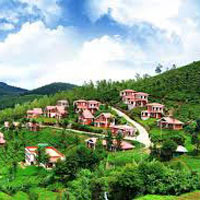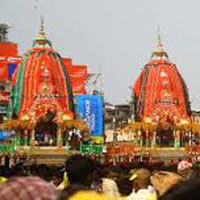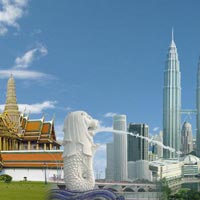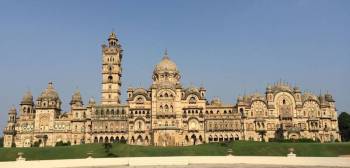10 Nights / 11 Days

Arrive at Delhi airport by mid night flight, meet and greet with our office representative, assistance and transfer to hotel. Rooms on immediate occupancy. Overnight at hotel.
After breakfast, check out and proceed for a half-day city tour visiting India Gate, Humayun tomb and Qutub Minar.
Later proceed to the airport for flight to Ahmedabad. On arrival, you will be met by our local representative and transferred to your hotel. Overnight at hotel.
Ahmadabad was founded by Sultan Ahmed Shah in 1411 AD and was graced with splendid monuments, mosques, pavilions and mausoleums, marking the beginning of the Indo-Saracenic style of architecture. Modern day Ahmedabad, popularly known, as the capital of the State of Gujarat is the largest city and a leading industrial center in Gujarat. It is also the sixth largest in India.
Popularly known as the Manchester of the East, Ahmedabad boasts of the largest denim production in the world. It is also home to several interesting museums. Many of Ahmedabad buildings bear the signatures of world-renowned architects like Le Corbusier, Louis Khan, Doshi and Correa. It is from the austere habitat of Sabarmati at Ahmedabad, that the 'Father of the Nation' - Mahatma Gandhi took on the mighty British Empire, and gave human race one of its most remarkable ways to fight oppression - non-violence.
Proceed for a full day sight seeing and shopping tour. Visit Shaking minarets - are two minarets located at the Siddhi Bashir mosque. They are uniquely designed in a way that when one minaret is shaken the other one shakes too. Calico textile museum - is one of the finest textile museums in the world. Housed in one of Gujarat's famous carved wooden havelis, the museum displays a magnificent collection of rare textiles that date back to the 17th century. There is also an excellent reference library on textiles. Sabarmati Ashram - On a quiet stretch of the river Sabarmati, 7 kms north of the city, Mahatma Gandhi set up a simple retreat in 1915. This was his first Satyagraha Ashram and for many it was the nerve center of India's freedom movement. Hridaya Kunj, the cottage where he lived is preserved as it was in the Mahatma's lifetime. The Gandhi Ashram has a memorial center, library and a sound and light spectacle to offer its visitors.
Vishala Vichar museum - is a restaurant with traditional Gujarati food in village surroundings. It has Vichar Utensil Museum worth visiting. The museum houses a unique collection of utensils. Kite museum - houses a wonderful variety of kites that depict their colorful history and regional flavors. Overnight at hotel.
After breakfast, check out and proceed to Bhavnagar. On arrival, check in at the hotel. Rest of the day is at leisure.
Bhavnagar lies in the southeast corner of the peninsular region of Gujarat known as Kathiawad or Saurashtra. Once the capital of a princely state, Bhavnagar is home to several lakes and temples. For the tourist, Bhavnagar serves as a convenient base to visit the Jain temples at Palitana on the Shatrunjaya hills and the Velvadar Sanctuary, the home of the famous Indian Black buck.
Founded in 1743 A.D., by Bhavsinhji Gohil, on the site of a small village of Vadva, near the creek, Bhavnagar was once a flourishing port. Today, however the only activities related to the sea near Bhavnagar take place at the port of Ghogha and at Alang, which is also, Asia's largest ship breaking facility.
The Nilambagh Palace was built in 1859 AD as the Yuvraj Bungalow (residence of the crown prince-of the Gohil Rajput clan). The Nilambagh palace is set in 40,000 sq.ft. of lawn and garden. The pillared portico, stepped arches, pleasant centre courtyard, turning marble staircase, the dining hall furnished with European chandeliers and the historic library are some highlights of the property. Overnight at hotel.
After breakfast, proceed for a full day excursion to Palitana temples and Velvadar Black buck sanctuary. Overnight at the hotel.
Velavadar Black buck sanctuary; is the home of the Indian black buck. Velavadar in the Bhal region of Saurashtra is a unique grassland ecosystem that has attracted fame for the successful conservation of the black buck - the fastest of the Indian antelopes, the wolf and the lesser florican.
Palitana - is a 'must visit' destination for all those who would like to witness what the subtle combination of human enterprise, architectural skills, philanthropy and channelized religious fervor can achieve. The entire summit of majestic mount Shatrunjaya is crowned with about 900 temples, each rivaling the other for beauty and magnificence, presenting an awe-inspiring spectacle to devotees and visitors. There are many temples at Palitana, which are revered by Hindus and some are prominent Jain pilgrim centers. Evening back to Bhavnagar. Overnight at hotel.
After breakfast, check out and proceed to Sasan Gir. On arrival, check in at the resort/ jungle lodge.
Afternoon safari in the Gir Wildlife Sanctuary; Sprawling in an area of 1424 sq. kms, Gir with its dry deciduous forest is a luxuriantly rich ecosystem- endowed with floral and faunal plentitude. Thirty species of mammals, twenty species of reptiles, several species of insects and birds are found here. The forest is the only place in the world, outside Africa, where the lion can be seen in its natural habitat. The number of lions in Gir had dwindled to a mere 15 by the turn of the century, due to extensive trophy hunting. The forest also harbors a number of smaller birds and animals. Other predators are the panther and the hyena. The largest Indian deer, Sambhar, Chital (spotted deer), Nilgai (blue bull), Chinkara and the unique Chowsingha (four horned antelope) are found here along with the bear and the long tailed langur.
Few people know that Gir is also one of the finest bird sanctuaries in India. Some of the typical birds of Gir are the crested serpent eagle, crested hawk eagle, brown fish owl, king vulture, jungle quail, paradise flycatcher, pygmy woodpecker, hard headed oriole etc. Adholia, Valadera, Ratanghuna and Pilipat are rewarding places for bird watching. Another attraction is a crocodile farm developed in the forest. Overnight at resort/ jungle lodge.
Breakfast at hotel, morning and evening safari in the national park. Rest time free for personal activities relax etc. Overnight at resort/ jungle lodge.
Breakfast at hotel, drive to Junagarh enroute visit Junagarh an ancient fortified city rich in myth and legend, Junagadh lies at the foot of the temple-studded Girnar Hill. It derives its name from the 'old fort', which circles the medieval town. The Girnar Hills that landscape Junagadh are a holy sanctuary to the Jains. The history of Mount Girnar dates back to the awesome empire of Ashoka, one of India's greatest emperors. Ashoka inscribed 14 edicts on a huge boulder en-route to Mt. Girnar peak. Junagadh's main feature is the Uperkot fort (upper fort), a somber and inaccessible fortress.
Ashoka's Rock Edicts; On the way to Girnar, there is a huge boulder, housed in a small roadside building, on which are fourteen Rock Edicts inscribed by Emperor Ashoka. As was the tradition of Kings of yore, in his quest to expand his empire, Ashoka fought fierce wars. After one of his most ferocious battles, a victorious Ashoka visited the battlefield of Kalinga. But the sight of mass slaughter of human beings had a catalytic effect on his mind. Remorse-stricken, he turned to Buddhism for absolution. He devoted rest of his life for the propagation and practice of Buddha's teachings.
The inscriptions carry Brahmi script in Pali language and date back to 250 B.C. The fourteen edicts of Emperor Ashoka are moral lectures. These edicts, preserved in the Girnar hills, bear testimony to the benevolent attitude and activities of the Emperor. On the same rock are inscriptions in Sanskrit added around 150 A.D. by Rudradama and in about 450 A.D. by Skandagupta, the last emperor of the Mauryas.
Uperkot Fort; is believed to have been constructed by the Yadavas (the clan to which Lord Krishna belonged) when they came to settle in Dwarka. Famous in bygone times for its virtual inaccessibility, the Uperkot or upper fort is girdled by a wall that is, in some places, over 20m. high. An ornate entrance gateway leads to the ruins. The fort has many interesting exhibits like the two guns placed on the western wall and believed to have been cast in Egypt. The bigger one is called the Nilamtope and the other one is known as Kadanal. In and around the fort one can find several Buddhist caves belonging to the 200 B.C. to 200 A.D era.
In the Uperkot is a two storied cave said to belong to the first century which is believed to be a Buddhist Chaitya cave. There are also Buddhist caves at Bava Pyara Math found below the Southern walls of Uperkot arranged in three rows. Scholars believe that they are Buddhist caves possibly belonging to the period between 200 B.C to 200 A.D.
Continue drive to Junagarh, on arrival check in at hotel. Overnight at hotel.
Breakfast at hotel, city tour of Gondal; the capital of the former princely state of Gondal, was ruled by the Jadeja Rajput clan, till the independence of India. Present day Gondal is a testimony to the great visionary ruler Sir Bhagwatsinhji, who introduced social reforms, planned the development of Gondal town and created a model state of Saurashtra in late 19th and early 20th century. Sir Bhagwatsinhji's high education and extensive tours to Europe enhanced his aesthetic tastes, which can be seen in the architecture and planning of public buildings, parks, bazaars and palaces built during his regime.
Navlakha Palace; One of the oldest and most beautiful of Gondal palaces, the Navlakha Palace complex, is situated on a riverbank, on a grand masonry base, rising to the monumental scale of at least 30 meters, above the riverbed. The palace is approached by the high gateway with the clock tower from the town side. The grand Darbar Hall, with a series of huge windows opening onto a long balcony supported by intricately carved brackets, overlooks the river. Darbar Hall has large chandeliers, stuffed panthers, gilt wooden furniture and antique Belgian mirrors. The private palace museum displays artifacts, gifts and messages received by Sir Bhagwatsinhji, on his 50th birthday.
Riverside Palace; The riverside palace is located at the edge of the Gondali River; built in colonial style of architecture, amidst a garden with huge trees. The living room is decorated in European taste, while the Indian room has brassware, beadwork and paintings in typical Indian style. The series of galleries and terraces of the palace building bring nature close to the visitors of this heritage hotel.
Orchard Palace; The Orchard Palace was originally a State guesthouse, built in colonial style with an arcade of semi circular arches, set in the midst of fruit orchards. The garden in the front, a beautiful fountain with lily pond and marble statues en chances the beauty of the palace. The main sitting room has a collection of paintings, antique furniture, bird eggs and many interesting art objects.
Vintage Car Collection; The rulers of Gondal were great lovers of automobiles and one can see several vintage and classic cars in the royal garage. Two rail saloons of the Gondal State were renovated, keeping the original décor and are available for accommodation in the Orchard Garden Palace. The stay at saloons provides a unique experience: a nostalgia of the great days of the Indian railways combined with royal grandeur. Overnight at hotel.
Breakfast at hotel, proceed to Wankaner. On arrival, check in at the hotel. Later visit Ranjit Vilas Palace and the step wells.
Wankaner derives its name from the geographical feature related to the location of the town: 'Wanka' means a bend and 'ner' means water stream in Gujarati. Wankaner literally means a bend on the stream and it is located on the bend of the Machchhu River. Wankaner was among the first few royal families of India to convert their palaces into Heritage Hotels, which have guestrooms, maintained in the original royal style.
Ranjit Vilas Palace; Amarsinhji built the Ranjit Vilas Palace on a hill, overlooking Wankaner town. It took seven years to complete and was designed by Amarsinhji himself. It was inaugurated by and named after his dear friend Jam Ranjitsinjhi of Jamnagar. The ground of the palace extends to two hundred and twenty five acres. The state guesthouse, Chandra Bhavan is also located in the same campus in the vicinity of the Ranjit Vilas Palace.
Step Well - Wankaner also has a step well, the last one to be built in Gujarat. In the Royal Oasis complex, the 3-storeyed step well, has 2 underground floors with cool subterranean marble rooms, fine sculptures and a fountain.
After breakfast, check out and proceed to Rajkot for a half day city tour. Later transfer to the airport for flight to Delhi/ Mumbai.
PML Travel Group Through Its Strategic Business Units and Partners Tour Operators World-wide, Caters to the Travel Needs of Varied Business Segments Viz, Individual Travel, Group Travel, Mice, Luxury Travel, Rail Journeys, Soft Adventure, Charter Operations, Cruise Handling , Museum Tours, Educational Trips, and Wellness Holidays. Our Strong Alliances in the South Asia Region Extend Into the Tourism Friendly Countries of Nepal and Bhutan. Read More...
 8D/7N
8D/7N
 7D/6N
7D/6N
 15D/14N
15D/14N
Bhubaneswar - Konark - Puri - Kolkata - Kalimpong - Pelling - Gangtok - Darjeeling ..
 20D/19N
20D/19N
Chennai - Mahabalipuram - Trichy - Madurai - Rameshwaram - Kanyakumari - Kovalam - ..
 17D/16N
17D/16N
Chennai - Mahabalipuram - Trichy - Madurai - Rameshwaram - Kanyakumari - Kovalam - ..
 15D/14N
15D/14N
Mumbai - Bangalore - Mysore - Ooty - Madurai - Mahabalipuram - Chennai - Kochi - Ta..
 15D/14N
15D/14N
Kolkata - New Delhi - Gangtok - Lachung - Yuksom - Pelling - Bagdogra - Yumthang - ..
 8D/7N
8D/7N
 12D/11N
12D/11N
New Delhi - Srinagar - Gulmarg - Pahalgam - Sonamarg - Kargil - Leh Ladakh
 11D/10N
11D/10N
 11D/10N
11D/10N
 11D/10N
11D/10N
 11D/10N
11D/10N
Bhopal - Pachmarhi - Jabalpur - Gwalior - Chhatarpur - Tikamgarh - Umaria
 11D/10N
11D/10N
 11D/10N
11D/10N
 11D/10N
11D/10N
Best of Gujarat With Wildlife Tour
Ahmedabad - Bhavnagar - Diu - Junagadh - Rajkot - Bhuj - Jamnagar - Dwarka - Mumbai
 11D/10N
11D/10N
 11D/10N
11D/10N
 12D/11N
12D/11N
11 Nights 12 Days - Delhi Agra Rajasthan
New Delhi - Mathura - Agra - Jaipur - Ajmer - Pushkar - Udaipur - Mount Abu - Ranak..
 11D/10N
11D/10N
10 Nights Uttar Pradesh Tour Package Fro..
New Delhi - Agra - Prayagraj - Lucknow - Mathura - Varanasi - Ayodhya - Vrindavan -..
 10D/9N
10D/9N
Gujarat Tour Package 9 Night - 10 Days
Ahmedabad - Junagadh - Porbandar - Rajkot - Dwarka - Somnath
 10D/9N
10D/9N
Gujarat Tour Package 9 Night - 10 Days
Junagadh - Rajkot - Vadodara (Baroda) - Dwarka - Somnath - Diu
 10D/9N
10D/9N
10 Days Gujarat Tour From Ahmedabad
Ahmedabad - Junagadh - Porbandar - Rajkot - Dwarka - Somnath
 9D/8N
9D/8N
8 Night - 9 Days Gujarat Tour Package
Ahmedabad - Junagadh - Porbandar - Vadodara (Baroda) - Dwarka - Somnath - Narmada
 9D/8N
9D/8N
8 Night 9 Days Gujarat Tour Package - 1
Junagadh - Porbandar - Dwarka - Somnath
 4D/3N
4D/3N
 8D/7N
8D/7N
Gujarat Tour Package 7 Night - 8 Days
Ahmedabad - Junagadh - Rajkot - Vadodara (Baroda) - Narmada